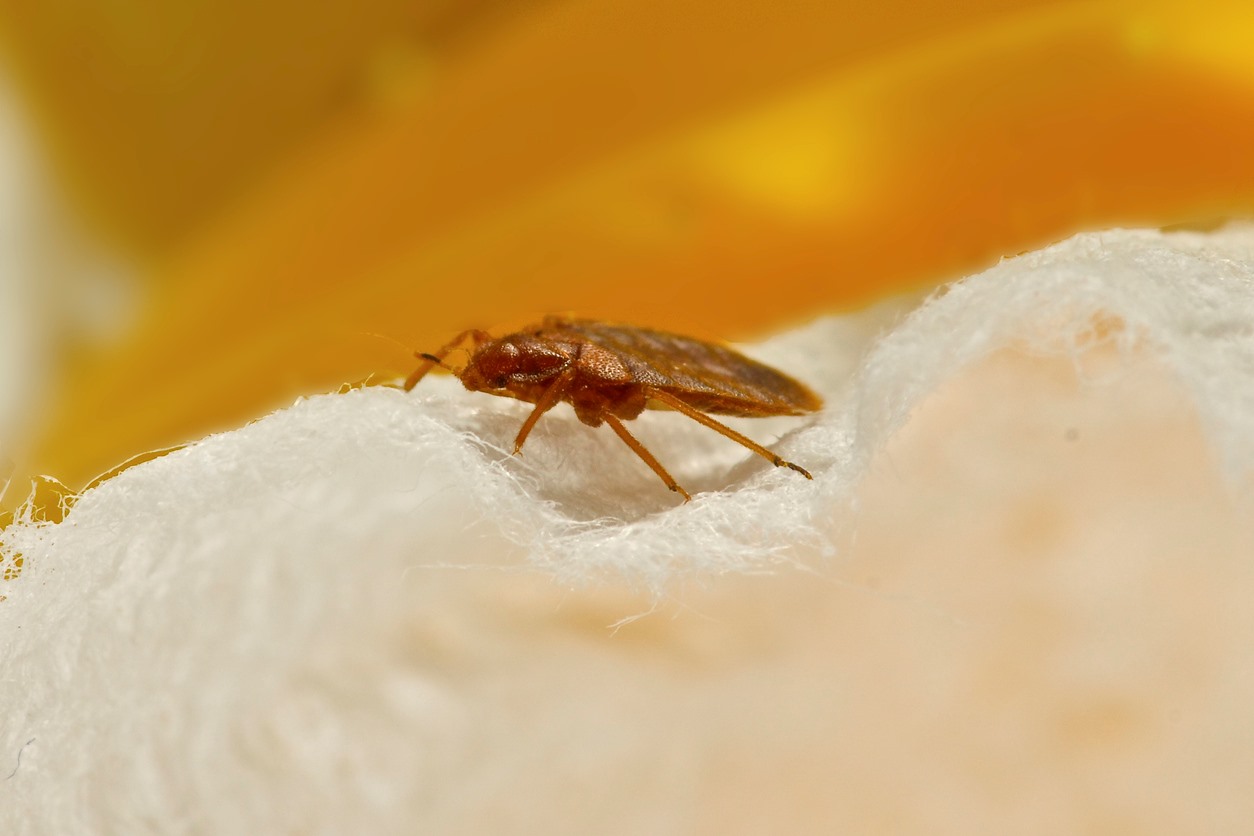
When it comes to identifying and treating bed bugs, there is a lot of incorrect information out there. Since we deal with bed bugs every day, the team at Clegg’s Pest Control wanted to provide some answers to frequently asked questions (a bed bugs FAQ) on what works and what doesn’t.
Identifying Bed Bugs
You may be able to identify bed bugs yourself by looking for the signs, including live bugs, exoskeletons along the edges of your mattress and box spring, blood spots on the mattress or linens, or evidence of bug bites.
There are home kits that you can purchase to test for bugs. The most effective of these is a saucer that contains a powder. Once they crawl into the saucer, they cannot get out. You can check the saucer daily to see if you catch any bed bugs. Alternatively, most pest control companies (Clegg’s included) offer free residential bed bug inspections. If bed bugs are found, the pest technician can then provide a treatment plan for your review.
Treating Bed Bugs
Pesticides
Bed bugs are notoriously resistant to pesticides, and many pesticides are dangerous, especially when sprayed in a sleeping area or around children and pets. Most safe pesticides do not leave residuals, meaning the bugs must come in contact with the pesticide before it dries. Bed bugs are good at hiding in cracks and crevices, so it can be hard to spray them all.
In addition, the insecticide levels in most over-the-counter pesticides are low. This can result in the bed bugs building up immunity to the pesticide, making it even harder to get rid of them for good. For fact sheets on specific pesticides, check the Environmental Protection Agency’s website.
Alcohol
Some folks recommend using alcohol as a temporary measure. The alcohol can kill the bed bugs if you spray them directly, and it can help to dehydrate any eggs you spray; however, in our experience, alcohol is not very effective and only delays resolving the problem.
Treating With Cold
According to recent research, in order to consistently kill bed bugs in a cold environment, they must be exposed to temperatures of 3 degrees Fahrenheit for a minimum of 80 hours. If you do have a freezer that enables you to maintain these low temperatures, you can treat smaller items like kids stuffed toys or non-washable items by sealing them in plastic bags in the infected room (you don’t want to spread the bed bugs as you move through your house) and putting them in the freezer for a week or two.
Steam Treatments
Some companies treat infestations with steam. This will kill bed bugs, however the steam comes from hot water and can cause damage to wallpaper, some paints, and some furnishings.
Treating With Heat
Currently the most effective way to treat bed bug infestations is using dry heat. Thermal heat treatments use equipment to bring the infected area up to a minimum temperature between 130 and 150 degrees and maintain the heat at that level for a period of time. This ensures that both live bugs and eggs are killed. A surface temperature of 120 degrees is lethal to the bugs, but the treatment temperature must be higher than that to ensure all areas (including between walls) are hot enough.
We have heard of companies that use electric heaters and go room to room to treat the house. Unfortunately, electric heaters generally cannot reach and sustain sufficiently high temperatures over a large enough area to effectively remove an infestation. Commercial LP gas heaters can achieve the necessary temperatures.
Microwaving
We have read stories of individuals trying to microwave library books to ensure they don’t have bed bugs. This can create a fire hazard and ruin the books (replacing library books can be expensive). We don’t recommend it.
Kerosene, Diesel, and Gasoline
All we can say is, DON’T DO IT! While these liquids will kill bed bugs, they are flammable and are all health hazards. We have seen several news stories over the past few years where people have tried to treat bed bugs themselves using these substances and ended up burning down their homes. Stay away from these fuels.
Boric Acid or Similar Powders
Others have tried treating bed bugs on their own using boric acid or other powders. In one case, there was so much powder laying on the surfaces of a home we were called to inspect, we would not take our bed bug dog inside due to the risk he would inhale the powder. We don’t recommend using these products.
Hard To Treat Items
Some items that are attractive to bed bugs, like Hoverounds®, wheelchairs and cars, are hard to treat. There are products that are effective in using an aroma to kill the bugs. These strips are placed in a sealed area (for example, we would place a Hoveround® in a large bag with the strips and seal it, or place them inside the car and leave it closed) and left for 72 hours. These aroma strips are very effective when directions are followed.
Cleaning and Decluttering
Removing clutter from your home is a good start to getting rid of bed bugs. They prefer to live in dark, enclosed spaces like behind headboards, under baseboards, and in cracks and crevices. It will help to remove items you don’t use (seal them in plastic before you remove them) and thoroughly clean and vacuum your home, sealing and tossing the vacuum cleaner bag.
This will not remove all the bed bugs, but will give the ones that remain fewer places to hide and make it easier for a pest professional to treat the area. You should also wash bed linens regularly in hot water (at least 120 degrees) and dry them on high heat. When you remove linens to wash them, place them in a plastic bag to transport to the laundry room and seal and dispose of the plastic bag afterwards.
Do I have to throw out my furniture?
Not usually. In most cases, when bed bugs are professionally treated your furnishings will also be effectively treated. The exception would be mattresses or upholstered pieces that were already damaged, allowing bed bugs deep into the upholstery. In such cases, treatments may not be effective in killing bugs that are protected by layers of padding.
If you have expensive mattresses you believe are infested, you may wish to use high quality mattress encasements to suffocate the existing bugs and prevent new ones from moving in. Damaged upholstered furniture may not be treatable. Also note that some inexpensive furniture that is made from particleboard with a plastic or vinyl coating may not hold up through a heat treatment.
Should I move?
No! The bed bugs will just move with you. Even if you leave the house with only the clothes on your back, you run the risk of taking along a hitchhiker and starting the cycle all over again. It’s best to treat the bugs in your home and inspect on a regular basis after treatment. Once the bed bugs have been gone for at least two months, you should be okay to move without risking contaminating your new living space. If you are planning on moving into a new home, you may wish to have a pest professional do a pre-move-in inspection.
Do bed bug encasements work?
A high quality bed bug encasement used on your mattress and box spring will suffocate any bugs still in the mattress and prevent more bed bugs from accessing the mattress. This is not a solution to the overall problem, but does make it easier to identify and deal with future problems.
We recommend that anyone who has their home treated for bed bugs use encasements on all mattresses and box springs in the house and leave them in place for a minimum of 24 months.
How can I make sure bed bugs don’t come back?
Having your house professionally treated will go a long way toward ensuring the infestation is eradicated. It’s also important to watch closely for signs of new bugs. Unfortunately, there is no foolproof method to keep bed bugs out of your house. If you are exposed to bed bugs that someone else has brought to a public location (or brought into your home), you may transport these bugs home with you. It is important to be vigilant!
A special note: We have recently heard of companies saying they will treat infestations on a room by room basis. This is not effective! You must treat the entire living area to ensure the infestation is removed. Even one bed bug in a second room in the house can begin the cycle all over again.
Not sure if you have bed bugs? Contact Clegg’s today and schedule a free residential bed bug inspection. If you do have bed bugs, our team will put together a treatment plan to resolve your bed bug problem.

